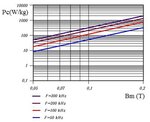MrCrowley
Newbie level 4
Hello,
I'm designing dc/dc flyback converter 10-42 to 3.3V/3A. I need efficency more then 75%. So on my prototype board I have about 50-60% and transformer core is heating up to 90 deg. I am using toroidal amorphous iron-based core with air gap. Length of middle line is 50.24mm, Magnetic permeability is 258, amplitude of induction Bm=1500 Gauss. Primal winding is 11 turns, secondary is 6, supply winding is 7 turns. So inductace is about 14uH in prim and 4uH in sec.
The question is why core is heating up? I was trying to use different frequencies from 60kHz to 800kHz. The transformer is not in saturation mode. It is working in discontinuos current mode. Everything seems to be good but its heating up. Why? I thought it can be losses in hysteresis or Eddi's current. But both of them will increase with rise of frequency and peak primary current. I was trying to reduce peak current from 4A to 1-2A, and freq to 60kHz, but losses were quiet same. Winding of several wires in parralel also didn't help. What is the reason of this heating and how the problem can be solved? Thanks.
I'm designing dc/dc flyback converter 10-42 to 3.3V/3A. I need efficency more then 75%. So on my prototype board I have about 50-60% and transformer core is heating up to 90 deg. I am using toroidal amorphous iron-based core with air gap. Length of middle line is 50.24mm, Magnetic permeability is 258, amplitude of induction Bm=1500 Gauss. Primal winding is 11 turns, secondary is 6, supply winding is 7 turns. So inductace is about 14uH in prim and 4uH in sec.
The question is why core is heating up? I was trying to use different frequencies from 60kHz to 800kHz. The transformer is not in saturation mode. It is working in discontinuos current mode. Everything seems to be good but its heating up. Why? I thought it can be losses in hysteresis or Eddi's current. But both of them will increase with rise of frequency and peak primary current. I was trying to reduce peak current from 4A to 1-2A, and freq to 60kHz, but losses were quiet same. Winding of several wires in parralel also didn't help. What is the reason of this heating and how the problem can be solved? Thanks.
